Winter Festivals
In 2009 Yanina Vihovska visited her home village of Pidhaitsi, near Lutsk. She made videos of a number of festivals.
——————————————————————————–
Christmas Eve
In Ukraine, Christmas is celebrated according to the Church calendar rather than according to the secular calendar. This calendar, also referred to as Old Style (OS), is 13 days behind the secular or New Style (NS) calendar. This means that Christmas falls on January 7 rather than December 25 and Christmas Eve is January 6. On the evening of January 6 (the day before Christmas Day ) the whole family gathers for a festive dinner that is also known as “Bahatyi vechir,” “The wealthy evening”. Christmas Eve commemorates the birth of Jesus of Nazareth. As a rule, there should be 12 different dishes at the table. Each dish is meatless, since it is the last day of the Advent Fast. The 12 dishes symbolize the Twelve Apostles. In the middle of the table there is a candle that represents Jesus as the Light of the World. The main drink of the evening is “Uzvar,” a traditional Christmas compote made out of boiled dried fruits (dried apples, pears, apricots, prunes, and so forth).
Traditionally, nothing is eaten all day and the family fasts until the first star appears in the evening sky. This star symbolically represents the Star of Bethlehem. When members of the family see that star, they gather around the table and sing the Lord’s Prayer. After the prayer, the main person in the household, usually the eldest male, the father or the grandfather (hospodar), takes the first spoon of “kutia” (a sweet grain pudding) and passes it to the rest of the family. Everyone has to try at least a spoon of kutia. After kutia, the family can eat all the rest of the 11 dishes and drink uzvar. In order to get rid of all the evil in household, there should be a clove of garlic at each corner of the table; usually it is hidden under the table cloth. At the end of the dinner, the youngest member of the family hides under the table and mimics different animal sounds. It is believed that the animals in that family’s household whose sounds he makes will reproduce successfully throughout the following year. As a rule, hospodar raises the first toast, celebrating the birth of Christ. The Christmas Eve meal has a vegetation fertility meaning as well as a religious one and this meaning fits with the attempt to insure that cattle and other farm animals will reproduce. The twelve dishes also represent the twelve months of the year and having 12 dishes at this time insures that there will be food on the table during all twelve months of the year. Having food that is made out of plants rather than animals is supposed to have a positive effect on the growth of crops and the candle in the middle is supposed to ensure that there is plenty of sunshine to help everything grow.
 Celebration of Christmas Eve |
 12 different dishes at the table |
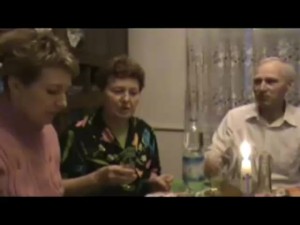 Hospodar the first to have kutia |
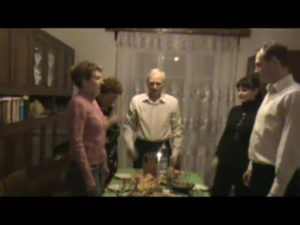 Nothing is eaten until the first star |
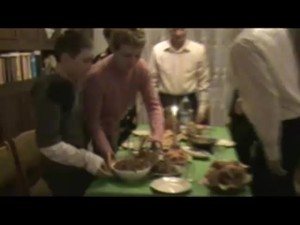 Kutia is a sweet grain pudding |
 A clove of garlic at each corner of the table |
——————————————————————————–
Old New Year
In Ukraine, New Year and Christmas are celebrated according to the Church calendar rather than according to the secular calendar. This calendar, also referred to as Old Style (OS), is 13 days behind the secular or New Style (NS) calendar. This means that New Year falls on January 14 rather than January 1. Therefore, people in Ukraine happily celebrate two New Years, one on the 1st of January and on the 14th.
New Years celebration on the 1st of January is usually celebrated outside the home. Typically, this is an occasion for going to a restaurant or a community hall. People wear formal attire such as long dresses for women and suits for men. At midnight, people perform a communal countdown to midnight. At the stroke of midnight, they congratulate each other with the arrival of the New Year.
The New Year’s Eve which is celebrated on January 13 is also known as the Old New Year. This is typically a traditional family celebration during which the family gathers at the home of one family member. They eat a big meal that traditionally features kutia. Carollers visit the home during the evening. The songs that they sing on this occasion are not of a religious nature. The carollers themselves dress in fancy costumes imitating animals or other figures. They frequently cross dress. Typically four or five groups of carollers can be expected to visit a regular village house. The carollers are paid by the hosts with gifts of food and sometimes money. On the morning of January 14th people practice a tradition that is called “posivannia”. This involves children throwing and scattering grain. Often they throw grain at old people, such as their grandparents. This is said in ensure good crops and to bring long life to the elderly.
The grain scattering ritual consists of young children going from house to house early in the morning and wishing everybody Happy Old New Year’s day. It is said that the first person to enter the house on that day should be a boy. Having a boy enter the house first insures the prosperity of the owners of the house in the coming year.
The children carry a small sack with grains in it; and while uttering New Year’s wishes, they throw grain on the house floor.
This is an example of a traditional New Year’s wish, recorded in Volyn region, Ukraine in 2010. Sometimes the children come in pairs (a boy and a girl) and utter New Year’s wishes in turns. One seldom sees two boys saying New Year’s wishes together.
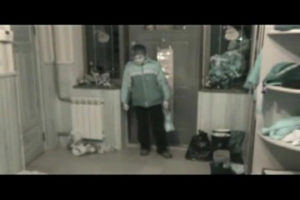 Children come and throw grain on the floor |
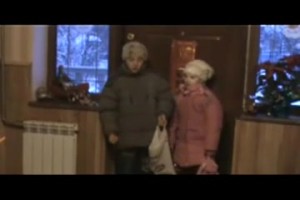 A boy and a girl say New Year’s wishes |
 One seldom sees two boys saying New Year’s wishes together. |
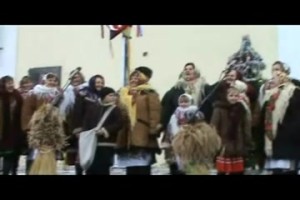 Scattering grain in entertainment programs |
——————————————————————————–
Koliada in the City
In Ukraine every big city has a major celebration of some sort on the second or third day after Christmas. In some cities, the municipal administration holds a concert and invites civic groups, schools, and village ensembles to join in the festivities. Such a concert was held in Lutsk, Volyn region. In Lutsk, the whole celebration was organized and advertised well in advance. Representatives from the Volyn region were invited and given a stipend to be able to come to Lutsk and take part in a folklore concert. This concert was held on an outdoor stage in the center of the city despite the cold weather. Wearing authentic costumes and performing the traditional songs of each particular village were greatly encouraged.
In addition to formal celebrations held on a stage, some cities now feature a different form of folklore-based presentation. In Lviv, for instance, many amateur groups came dressed in traditional vertep costumes and walked around the city with musicians. They went to popular restaurants and bars where they gave a little performance that culminated in gathering money from the patrons. Also, some groups decided to dress up as kozaks and just walk around the main streets of the city singing traditional kozak songs and posing for photographs with tourists.
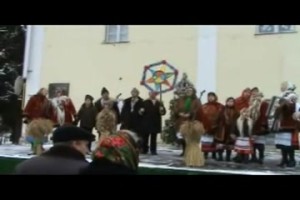 Here you can hear one of the groups singing a song well known in their village. |
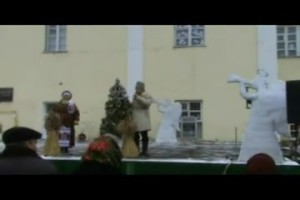 In Lutsk a man and a women were hosts called: hospodar and hospodynia. |
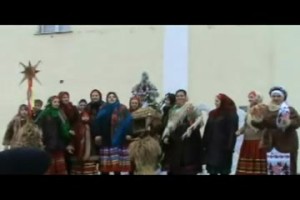 A group does a vertep performance based on the birth of Christ. |
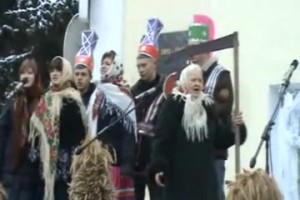 Here all the actors have special costumes in the birth of Christ scene. |
 Carollers in Lviv performing and collect money from people. |
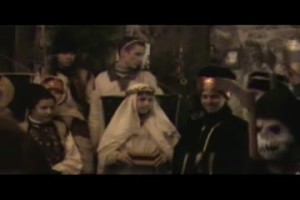 A vertep performance in a popular restaurant in Lviv - Kryjivka. |
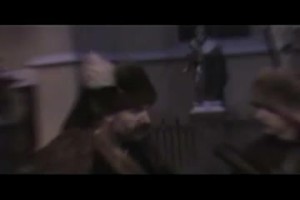 Taking pictures of kozaks was very popular with tourists. |
——————————————————————————–
Carolling
In Ukraine, kids and youths like to go carolling. Sometimes adults go carolling as well, but usually it is done for a particular cause, like to collect money for a church or to obtain funds for a specific organization. As a rule, people are going carolling on the evening of January 6 (the day before Christmas Day) and all day on January 7th. During these two days people sing koliadky.
However, in the evening on January 13th youths dress up in funky clothes and go around the village singing a specific kind of carols that are called “schedrivky”.
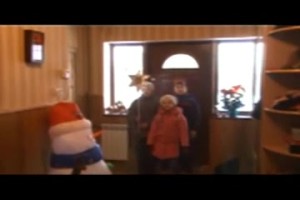 A girl and 2 boys are singing koliadky in the village of Pidhaitsi, Volyn 2010. |
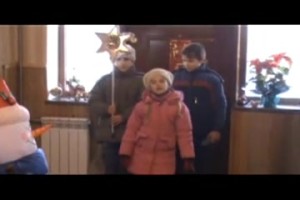 Since Volyn region is very close to Poland, some carollers carol in the Polish language. |
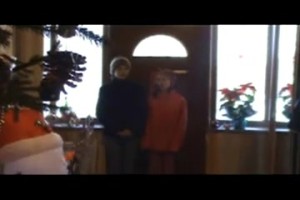 This is another couple of carollers from the village of Pidhaitsi, Volyn 2010. |
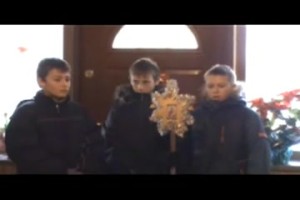 A homemade star is one of the important attributes of the carollers. |
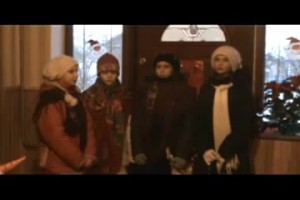 This is an example of girls carollers in the village of Pidhaitsi, Volyn 2010. |
——————————————————————————–
Yordan
On the morning of January 19th, everybody rushes to church to attend the Divine Liturgy and the Blessing of Water. Since not everybody can have this day off, people go to church all day long. They have one goal: to fill their bottles with holy water.
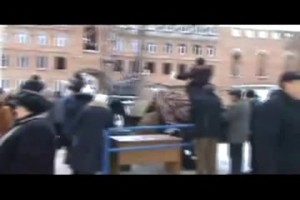 In order to get some water, people have to bring their own bottles or containers. |
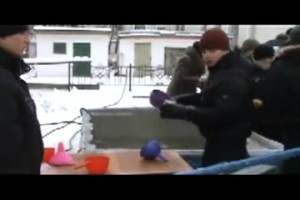 Usually there is a big line-up for the water; the line remains long the whole day. |

